 W
WAdurbadagan was a Sasanian province located in northern Iran, almost corresponded to the present-day Iranian Azerbaijan. Governed by a marzban ("margrave"), it functioned as an important frontier region against the neighbouring country of Armenia.
 W
WAllar Cave is an archaeological site and Middle Paleolithic human settlement. The cave is situated on the left bank of the Vilesh River, in Allar village, Yardymli Rayon, Azerbaijan, at an altitude of 1,500 metres (4,900 ft) above sea level.
 W
WThe Bavand dynasty, or simply the Bavandids, was an Iranian dynasty that ruled in parts of Tabaristan (Mazandaran) in what is now northern Iran from 651 until 1349, alternating between outright independence and submission as vassals to more powerful regional rulers.
 W
WThe Cadusian Campaign was a military campaign of King Artaxerxes II of Persia in 385 BC against the Cadusii. The origins of the campaign are not attested in historical sources, but it was probably in response to a revolt of the Cadusii and the refusal of paying tribute.
 W
WThe Cadusii were an ancient non-Iranian or Iranian people living in north-western Iran.
 W
WThe Caspian expeditions of the Rus' were military raids undertaken by the Rus' between 864 and 1041 on the Caspian Sea shores, of what are nowadays Iran, Dagestan, and Azerbaijan. Initially, the Rus' appeared in Serkland in the 9th century traveling as merchants along the Volga trade route, selling furs, honey, and slaves. The first small-scale raids took place in the late 9th and early 10th century. The Rus' undertook the first large-scale expedition in 913; having arrived on 500 ships, they pillaged in the Gorgan region, in the territory of present-day Iran, and more to the west, in Gilan and Mazandaran, taking slaves and goods. On their return, the northern raiders were attacked and defeated by the Khazars in the Volga Delta, and those who escaped were killed by the local tribes on the middle Volga.
 W
WThe Caspians were a people of antiquity who dwelt along the southwestern shores of the Caspian Sea, in the region known as Caspiane. Caspian is the English version of the Greek ethnonym Kaspioi, mentioned twice by Herodotus among the Achaemenid satrapies of Darius and applied by Strabo. The name is not attested in Old Iranian.
 W
WThe Dabuyid or Gaubarid Dynasty was a Zoroastrian Iranian dynasty that started in the first half of the seventh century as an independent group of rulers, reigning over Tabaristan and parts of western Khorasan. Dabuyid rule over Tabaristan and Khorasan lasted from ca. AD 642 to the Abbasid conquest in 760.
 W
WGīlān is an Iranian province at the southwestern coast of the Caspian Sea. This articles discusses its history.
 W
WIspahbads of Gīlān or Esfahbad of Gīlān was a small principality in Iran. In the 14th century, Āstārā became the seat of the principality.
 W
WThe Justanids or Jostanids were an Iranian Zaydi Shia dynasty that ruled a part of Daylam from 791 to the late 11th-century.
 W
WThe Kar-Kiya dynasty, also known as the Kiya'ids, was a Zaydi Shia dynasty which ruled over Biya-pish from the 1370s to 1592. They claimed Sasanian ancestry as well. Lahijan was the dynasty's capital.
 W
WThe Khurramites were an Iranian religious and political movement with its roots in the movement founded by Mazdak. An alternative name for the movement is the Muḥammira, a reference to their symbolic red dress.
 W
WMīrzā Kūchak Khān was an Iranian twentieth-century revolutionary leader and the president of the Persian Socialist Soviet Republic. He was the founder of a revolutionary movement based in the forests of Gilan in northern Iran that became known as the Nehzat-e Jangal . This uprising started in 1914 and remained active against internal and foreign enemies until 1921 when the movement was completely abandoned after the demise of Mirza Kuchak Khan.
 W
WLankaran Uyezd was an administrative unit within the Baku Governorate of the Russian Empire, and then of the Azerbaijan Democratic Republic and the Azerbaijan SSR, with its centre in the city of Lankaran until its formal abolishment in 1929 by Soviet Authorities. The uyezd was located on the southern part of the governorate, bordering Caspian sea to the east, Javad Uyezd to the north and Persia to the west and south.
 W
WGrand Ayatollah Mohammad Fazel Lankarani was an Iranian Twelver Shia Marja'. He was student of Grand Ayatollah Borujerdi. He was a child of a Persian mother and an Azerbaijani father.
 W
WMarlik is an ancient site near Roudbar in Gilan, in northern Iran. Marlik, also known as Cheragh-Ali Tepe is located in the valley of Gohar Rud, a tributary of Sepid Rud in Gilan Province in Northern Iran, Marlik. Marlik is the site of a royal cemetery, and artifacts found at this site date back to 3,000 years ago. Some of the artifacts contain amazing workmanship with gold. Marlik is named after the Amard people.
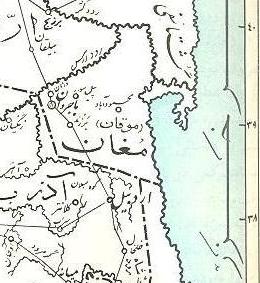 W
WMughan was a province of the Abbasid Caliphate, in present-day Iranian Azerbaijan. The capital was Bajravan. Other cities were Barzand, Pilsavar, Mahmood Abad and Dezhman. Mughan State was located west of Caspian Sea and south of the Aras river, encompassing the namesake plains region.
 W
WThe Mughan Soviet Republic was a short-lived pro-Bolshevik state that existed in present-day southeastern Azerbaijan from March to June 1919. It was founded in opposition to the Musavatist Azerbaijani Government in Baku.
 W
WPaytakaran was the easternmost province of the Kingdom of Armenia. The province was located in the area of the lower courses of the rivers of Kura and Araks, adjacent to the Caspian sea. Today, the area is located in the territory of modern-day southeastern Azerbaijan and northwestern Iran.
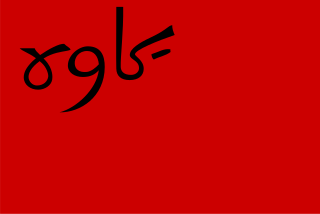 W
WThe Persian Socialist Soviet Republic, also known as the Soviet Republic of Iran or Socialist Soviet Republic of Gilan, was a short-lived unrecognized state, a Soviet republic in the Iranian province of Gilan that lasted from June 1920 until September 1921. It was established by Mirza Koochak Khan, a leader of the Constitutionalist movement of Gilan, and his Jangali partisans, with the assistance of the Soviet Union's Red Army.
 W
WThe Provisional Military Dictatorship of Mughan was a British-controlled anti-communist short-lived state founded in the Lankaran region on August 1, 1918. The Mughan government did not support independence of Azerbaijan and it was led by white Russian colonel T. P. Sukhorukov who acted under the protection of the British occupation of Baku. Mughan declared to be an autonomous part of "single and indivisible Russia." On December 1918, it was reorganized as Mughan Territorial Administration. On April 25, 1919, a violent protest organized by Talysh workers of pro-Bolshevik orientation exploded in Lankaran and deposed the Mughan Territorial Administration. On May 15, the Extraordinary Congress of the "Councils of Workers' and Peasants' Deputies" of Lankaran district proclaimed the Mughan Soviet Republic.
 W
WThe Qarinvand dynasty, or simply the Karenids, was an Iranian dynasty that ruled in parts of Tabaristan (Mazandaran) in what is now northern Iran from the 550s until the 11th-century. They considered themselves as the inheritors of the Dabuyid dynasty, and were known by their titles of Gilgilan and Ispahbadh. They were descended from Sukhra, a Parthian nobleman from the House of Karen, who was the de facto ruler of the Sasanian Empire from 484 to 493.
 W
WRawwadid or Ravvadid or Banū Rawwād (955–1071), was a Muslim ruling family centered in historic Azerbaijan between the late 8th and early 13th centuries.
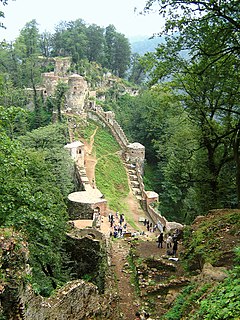 W
WRudkhan Castle ; also Roodkhan Castle, is a brick and stone medieval fortress in Iran that was built by the Gilaks to defend against the Arab invaders during the Arab/Islamic invasion of Sassanian Iran. With the fall of the Sassanid Empire, this area became a defensive position against the Arabs in the then-newly established Tabarestan.
 W
WThe region of Talish was a region of the Safavid Iran (1501–1736), loacated in the greater Talish, present-day divided between Iran and Azerbaijan countries. The territory of the region was principally made up of the two subordinate governorates of "Astara" and "Lankaran". The city of Astara was its administrative center, the base of Safavid power in the region.
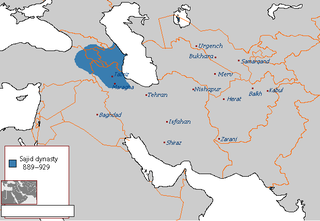 W
WThe Sajid dynasty, was an Iranian Muslim dynasty that ruled from 889-890 until 929. The Sajids ruled Azerbaijan and parts of Armenia first from Maragha and Barda and then from Ardabil. The Sajids originated from the Central Asian province of Ushrusana and were of Iranian (Sogdian) descent. Muhammad ibn Abi'l-Saj Diwdad the son of Diwdad, the first Sajid ruler of Azerbaijan, was appointed as its ruler in 889 or 890. Muhammad's father Abu'l-Saj Devdad had fought under the Ushrusanan prince Afshin Khaydar during the latter's final campaign against the rebel Babak Khorramdin in Azerbaijan, and later served the caliphs. Toward the end of the 9th century, as the central authority of the Abbasid Caliphate weakened, Muhammad was able to form a virtually independent state. Much of the Sajids' energies were spent in attempting to take control of neighboring Armenia. The dynasty ended with the death of Abu'l-Musafir al-Fath in 929.
 W
WStone sculptures of horses and sheep – are zoomorphic headstones, spread in the South Caucasus, Western Armenia and Iranian Azerbaijan, the main part of which is dated back to the 13th-19th centuries.
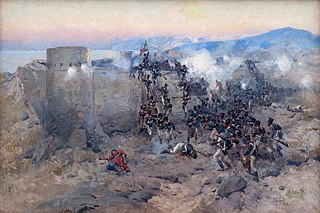 W
WThe Storming of Lankaran took place on 1 January 1813 as part of the Russo-Persian War (1804-1813). It was noted for its bitterness and cruelty.
 W
WTalish-i Gushtasbi is the historical name of the northern Talish area, presently a part of the Republic of Azerbaijan. During the Abbasid Caliphate, there was a region called Gushtasfi. People of northern Talysh are of Iranian stock and speak a northwestern Iranian language called Talysh. The chief cities of the area are Talesh, Lankaran, Lerik, Masally and Astara.
 W
WTalysh Khanate or Talish Khanate was a khanate of Iranian origin that was established in Persia and existed from the middle of the 18th century till the beginning of the 19th century, located in the south-west coast of the Caspian Sea.
 W
WThe Talysh-Mughan Autonomous Republic (Azerbaijani: Talış-Muğan Muxtar Respublikası, Talysh: Толъш-Мъғонә Мохтарә Республикә was a short-lived self-proclaimed separatist autonomous republic in Azerbaijan, that lasted from June to August 1993. It was located in extreme southeastern Azerbaijan, envisaging to consist in the 7 administrative districts of Azerbaijan around the regional capital city Lankaran: Lankaran, Lankaran rayon, Lerik, Astara, Masally, Yardymli. Historically the area had been a khanate. The flag of the Talysh-Mughan Autonomous Republic and the modern Talysh flag is a vertical tricolor of red, white, and green with a centered rising sun over blue sea.
 W
WThe Talysh National Movement - Talysh movement, created in 2007 in the Netherlands, where part of the Talysh leadership lives in exile. Many of the movement's members had previously participated in the formation of the Talysh-Mugan Autonomous Republic in 1993, including board member Alikram Hummatov.
 W
WThe Ziyarid dynasty was an Iranian dynasty of Gilaki origin that ruled Tabaristan from 930 to 1090. At its greatest extent, it ruled much of present-day western and northern Iran.
Zurvanism is an extinct branch of Zoroastrianism in which the divinity Zurvan is a First Principle who engendered equal-but-opposite twins, Ahura Mazda and Angra Mainyu. Zurvanism is also known as "Zurvanite Zoroastrianism", and may be contrasted with Mazdaism.